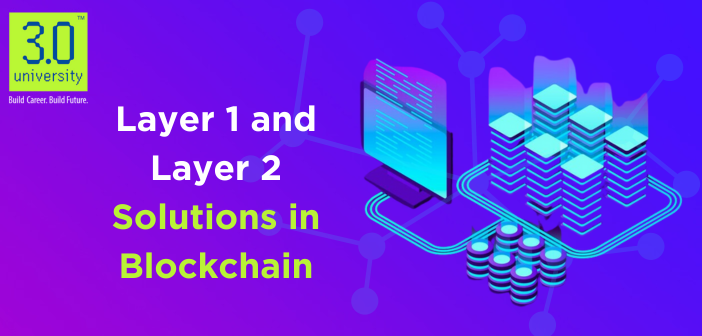
Layer 1 and Layer 2 Solutions in Blockchain
- Posted by 3.0 University
- Categories Blockchain
- Date June 14, 2023
- Comments 0 comment
Layer 1 and Layer 2 Solutions in Blockchain
Layer 1 solutions are Blockchain protocols that are used to process transactions and create blocks on the Blockchain.
Examples of Layer 1 solutions include Bitcoin, Ethereum, Ripple, Litecoin, etc.
Layer 2 solutions are technologies built on top of existing Blockchain protocols. These solutions help improve the scalability, speed, and privacy of Blockchain networks.
Examples of Layer 2 solutions include lightning networks, state channels, and sidechains.
Different types of Layer 2 Solutions and its Salient features
- State Channels: State channels assist to improve scalability and reduce transaction fees as well. It allows for two or more parties to transact off-chain and every transaction is not required to be broadcast to the entire network. A multi-signature smart contract is created to execute the transactions.
- Payment Channels: Payment channels are similar to state channel but restricted to payments only. They are of two types – i) Built on top of a blockchain and ii) off-chain payment channel. Only opening and closing of payment channel are recorded on the Blockchain thus significantly reducing the load on the main network.
- Sidechains: Sidechains is a scalability solution which are pegged to the main Blockchain. These sidechains are connected to the main Blockchain and allow for transactions to take place on the sidechain, while still being secured by the main Blockchain. This allows for increased scalability and performance, without sacrificing security.
- Plasma: Plasma uses smart contracts and Merkle trees to create any number of “child copies” of the “parent Blockchain”. Each “child chain” acts as a separate blockchain with its own nodes, block size, consensus algortithm etc. The first transaction has to be created on the main blockchain and then linked to the plasma chain by means of smart contracts.
Plasma is a scaling solution for Ethereum, allowing for a large number of transactions to be processed off-chain, while still maintaining a high level of security and decentralization. This solution allows for a much higher throughput of transactions than what is possible on the main Ethereum chain, without sacrificing the security or decentralization of the network.
Layer 2 solutions improve performance of Blockchain
- Increase scalability by implementing Sharding and state channels: Sharding is a scaling technique that divides a Blockchain network into multiple pieces (shards) that can run parallel transactions. This increases the network’s throughput and allows it to process more transactions in a shorter amount of time. State channels are also a scalability solution that allows users to exchange digital assets without having to broadcast every transaction to the Blockchain, thus reducing congestion.
- Introduce new consensus mechanisms: Layer 2 solutions can benefit from alternative consensus mechanisms like Delegated Proof of Stake (DPoS) and Proof of Stake (PoS). These consensus algorithms are more efficient than the traditional Proof of Work (PoW) and can reduce the cost of transactions while still ensuring the security of the network.
- Implement sidechains: Sidechains are separate Blockchain that are connected to the main Blockchain, allowing for more efficient transactions and greater scalability. Sidechains can be used to transfer assets between different Blockchain, allowing for more efficient and secure transactions.
- Improve network latency: Network latency is the time it takes for a transaction to be processed and confirmed on the Blockchain. If the network latency is too high, users will experience slow transaction times
Overall Layer 2 Solutions work towards solving the Blockchain trilemma.
You may also like
Disruption Readiness of Blockchain Education
Blockchain technology has the power to revolutionize the education industry to the core by offering a secure, transparent, and efficient system for managing learning records and facilitating learning. In the future, education will embrace blockchain, securing the quality and accessibility …
How Blockchain Transforms Digital Signage?
Blockchain might transform audience targeting tokenized advertising models, content rights protection and management, and decentralized digital signage applications. Experts, facts, and real-world cases depict the disruptive potential of the blockchain and the challenges of adoption. We need to understand blockchain …
Rise of Decentralized Autonomous Organizations
An academic review of DAOs redefines professional progress with others, not only education and research. This approach may assist students, job seekers, and professionals in identifying new possibilities and academicizing the world. As one maps over the terrain of DAOs …
